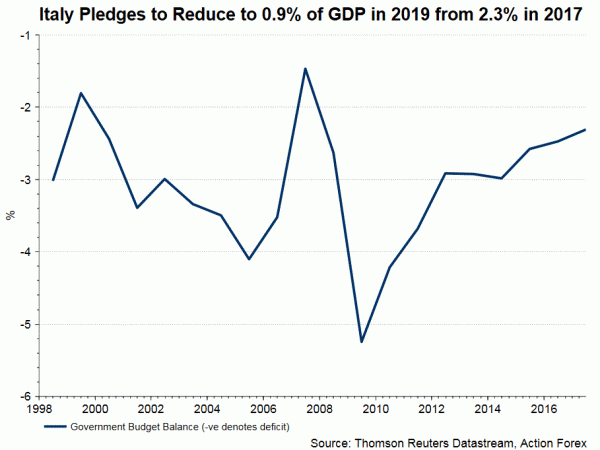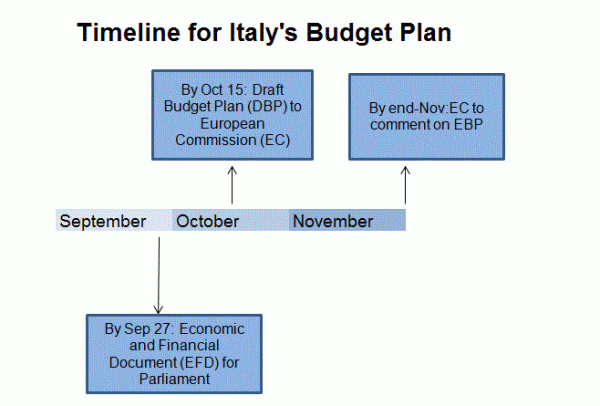There is a comeback of concerns over Italy’s financial situation as next year’s fiscal budget would soon be revealed. As an election promise, the populist M5S/League coalition government could likely propose a number of expansionary measures including tax cut and increase in welfare. Such worries have been exacerbated by actions of credit rating agencies, triggering panic selloff of the country’s bonds. 10-year Italy –German yield spread has widened to the highest level since 2013, surpassing the level in May when the market was unnerved by the formation of the new government.
Fiscal Budget to Worsen Debt Situation
Back in May, M5S and the League reached an agreement in principle on a program called “Contract for the government of change”. Notwithstanding the vague and general language used, the government’s aim at fiscal loosening is obvious. One of the important points lain down in the agreement was flat tax and simplification, proposing to freeze VAT and excise taxes. At the time same, it also proposed to reduce public debt through GDP growth, rather than through tax- and austerity-based measures. According to former fiscal commissioner and IMF alumnus Cottarelli, the measures might result in a deficit slippage of 108-125B euro (6-7% GDP), in addition to the current 30B euro (1.7% GDP).
We expect to get more details about the budget plan as the government releases the Economic and Financial Document (DEF) by September 27. The document should paths for public debt and deficit targets for the period from 2018 to 2021. This would be followed by submission of draft budget plan (DBP) to the European Commission by October 15. The European Commission would announce its assessment by November 30.
We expect huge volatility in the financial markets as we approach the key dates. However, the Italian government is not free to implement whatever policy it wants. For instance, the European Commission could request the government to amend the DBP if it judged that the plan is non-compliant. It could even launch a significant deviation procedure or an Excessive Deficit Procedure (EDP). Meanwhile, the plan would have to be voted in the Italy’s parliament for approval. The coalition government has a thin majority in the upper house, making the hurdle for passing any bill quite high.
Rating Downgrades can Further Erode Borrowing Ability
Last Friday, Fitch revised Italy’s sovereign outlook to “negative” from “stable, while affirming the rating at BBB. As the accompanying suggested, Fitch expects Italy’s fiscal loosening would leave the country’s “very high level of public debt more exposed to potential shocks”. The agency noted that the downside risks to the fiscal forecast projected in March have increased, as a result of “the new and untested nature of the government, the sizeable policy differences between its coalition partners, and inconsistencies between the high cost of implementing new pledges as set out in its policy “Contract” and its stated objective to reduce public debt”. Weeks ago, Moody’s announced to extend its review on the country’s possible downgrade to end-October, as the agency seeks to clarify on Italy’s fiscal path and reform agenda. The potential downgrade has been driven by “(1) the significant risk of a material weakening of Italy’s fiscal strength, given the fiscal plans of the new government that took office in early June; and (2) the risk that structural reform efforts may stall, or that important past reforms such as the 2011 pension, or the 2015 labour market reforms, could be reversed”.
Italy’s Sovereign Rating by Major Credit Rating Agencies
| Agency | Rating | Outlook | Notch above Junk Grade | Last Review | Next Review |
| Fitch | BBB | Negative | 2 | Aug 31, 18 | Jan-Feb, 19 |
| Moody’s | Baa2 | Negative | 2 | May 25, 18 | End-Oct,18 |
| S&P | BBB | Stable | 2 | Apr 27, 18 | Oct 26,18 |
Downgrades of the sovereign rating would future erode the government’s ability to borrow in the international capital markets, creating a vicious debt cycle that could be detrimental to the economy. We have all learnt a painful lesson from Greece in the European sovereign debt crisis almost a decade ago. In October 2009, the newly election Greek government unveiled its previous government had grossly under-reported its budget deficit which was in fact expected to reach 12.5% of GDP, compared with Eurozone membership’s threshold of 3%.This had quickly eroded investor confidence, causing bond spreads to rise to unsustainable levels. Fears spread that the fiscal positions and debt levels of a number of Eurozone countries were unsustainable. Over the 2 months through December, the top 3 credit rating agencies downgraded Greece’s sovereign rating by 4 times. The Greek/German 10-year debt yield spread surpassed 300 bps in January 2010. Despite austerity measures, S&P’s downgraded Greek credit rating to “junk” in April, lifting the debt yield spread to above 1000 bps. Completely shutting the door for the country to borrow from the financial markets, Greece had to seek bailout from IMF/EU/EC bailout in May, together with the third austerity package. While Italy’s rating is still 2 notches above junk level in all three agencies, we expect the market would closely monitoring any possible actions.


















